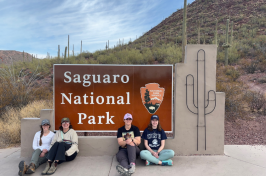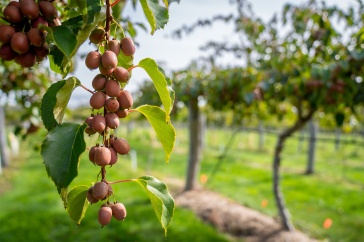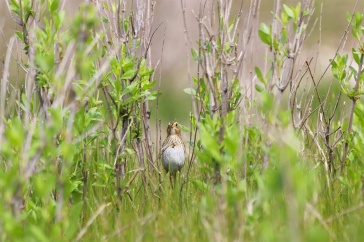
Andrew Uccello, field and lab technician, analyzes one of more than 1,200 scat samples collected from small mammals at the Bartlett Experimental Station in the White Mountain National Forest to determine the types and amounts of spores they are dispersing. (Credit: UNH)

time when many seeds are germinating. (Credit: UNH)
Small mammals such as mice and chipmunks who are not picky eaters play a more important role than previously known in dispersing the spores of wild mushrooms and
truffles, according to new research from the New Hampshire Agricultural Experiment Station at the University of New Hampshire.
Mushrooms and truffles are key components to forests where they colonize the roots of plants and assist with water and nutrient uptake. They also play a fundamental role in helping reestablish plants following disturbances such as wildfires, volcanic eruptions, and the retreat of melting glaciers.
The research was conducted by Ryan Stephens, a postdoctoral researcher, and Rebecca Rowe, associate professor of natural resources and the environment. Scientists spent three years collecting and analyzing more than 1,200 scat samples collected from small mammals at the Bartlett Experimental Station in the White Mountain National Forest to determine the types and amounts of spores they are dispersing.
They found that generalist rodent species--those that consume a wide variety of food items--can be important dispersers of mycorrhizal fungi, which are the spores produced in fruiting bodies such as mushrooms and truffles. They are especially effective when their population increases.
“When generalist rodent populations are on the rise, they can disperse more fungal spores than dietary specialists such as the southern red-backed vole that consume fungi as their main food source. Additionally, because they use a wide variety of habitats, they can disperse spores to areas that dietary specialists rarely inhabit,” Stephens said.
Moreover, generalist rodents such as mice and chipmunks disperse fungal spores at a time when many seeds are germinating. Stephens explained that this is the period when mycorrhizal colonization is key for the survival and growth of tree seedlings. Thus, not only are generalists important dispersers of fungal spores, but they do so at a critical phase for establishing seedlings.
Previously, scientists long thought only specialists such as northern flying squirrels and southern red-backed voles that consume fungi as their main food were the most important dispersers of mycorrhizal fungi. Experiment station scientists wanted to determine if species that do not specialize in eating fungi but still feed on it also contribute to spore dispersal.

mammals such as voles, mice, and chipmunks consume mushrooms and
truffles and deposit the spores to new areas in their scat. (Credit: UNH)
These new findings are important as mycorrhizal fungi are key components to forest sustainability and health. Fungi colonize plant roots and assist with water and nutrition uptake. All tree species in New England form this mutualistic association, and some tree species cannot survive without mycorrhizal fungi.
“Most mushroom spores only disperse a short distance from the cap by wind. Truffles fruit below ground and cannot disperse on their own. To aid in their dispersal, small mammals such as voles, mice, and chipmunks consume mushrooms and truffles and deposit the spores to new areas in their scat. Thus, similar to pollinators, small mammals serve an important role in ecosystems as dispersers of mycorrhizal fungi,” Stephens said.
“Small mammals occupy most forested habitats and can reach high populations. Although they are important consumers, much remains unknown about how their consumption of food and use of different habitats influences forest composition and regeneration. Our research demonstrates that both specialist and generalist rodents are important for dispersal of mycorrhizal fungal spores,” Rowe said.
Going forward, scientists will investigate if small mammals play an important role in dispersing mycorrhizal fungi after forest disturbances such as timber harvests and clear cuts since mycorrhizal fungi die when trees are removed. Small mammals may play a key role in bringing spores of mycorrhizal fungi into clear cuts, which would help repopulate the mycorrhizal fungal community and aid in tree regeneration.
This research is presented in the journal Ecology in the article “The underappreciated role of rodent generalists in fungal spore-dispersal networks (DOI: https://doi.org/10.1002/ecy.2972).
This material is based upon work supported by the NH Agricultural Experiment Station, through joint funding of the National Institute of Food and Agriculture, U.S. Department of Agriculture, under award numbers 1016133 and 1006881, and the state of New Hampshire. Additional support was provided by the Northern Research Station of the USDA Forest Service, University of New Hampshire Natural Resources and the Environment Student Support Fund, American Society of Mammalogists, and the Mycological Society of America: Forest Fungal Ecology Research Award.
Founded in 1887, the NH Agricultural Experiment Station at the UNH College of Life Sciences and Agriculture is UNH’s original research center and an elemental component of New Hampshire's land-grant university heritage and mission. We steward federal and state funding, including support from the USDA National Institute of Food and Agriculture, to provide unbiased and objective research concerning diverse aspects of sustainable agriculture and foods, aquaculture, forest management, and related wildlife, natural resources and rural community topics. We maintain the Woodman and Kingman agronomy and horticultural research farms, the Macfarlane Research Greenhouses, the Fairchild Dairy Teaching and Research Center, and the Organic Dairy Research Farm. Additional properties also provide forage, forests and woodlands in direct support to research, teaching, and outreach.
-
Written By:
Lori Wright, '06G | NH Agricultural Experiment Station | lori.wright@unh.edu | 16038621452

















































